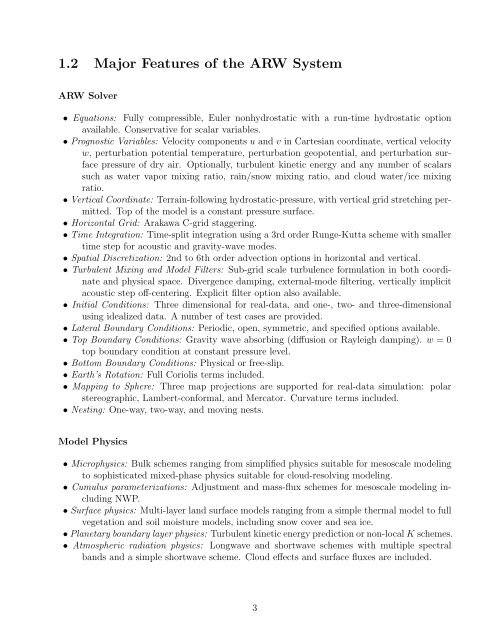Advanced Research WRF (ARW) Technical Note - MMM - University ...
Advanced Research WRF (ARW) Technical Note - MMM - University ...
Advanced Research WRF (ARW) Technical Note - MMM - University ...
You also want an ePaper? Increase the reach of your titles
YUMPU automatically turns print PDFs into web optimized ePapers that Google loves.
1.2 Major Features of the <strong>ARW</strong> System<br />
<strong>ARW</strong> Solver<br />
• Equations: Fully compressible, Euler nonhydrostatic with a run-time hydrostatic option<br />
available. Conservative for scalar variables.<br />
• Prognostic Variables: Velocity components u and v in Cartesian coordinate, vertical velocity<br />
w, perturbation potential temperature, perturbation geopotential, and perturbation surface<br />
pressure of dry air. Optionally, turbulent kinetic energy and any number of scalars<br />
such as water vapor mixing ratio, rain/snow mixing ratio, and cloud water/ice mixing<br />
ratio.<br />
• Vertical Coordinate: Terrain-following hydrostatic-pressure, with vertical grid stretching permitted.<br />
Top of the model is a constant pressure surface.<br />
• Horizontal Grid: Arakawa C-grid staggering.<br />
• Time Integration: Time-split integration using a 3rd order Runge-Kutta scheme with smaller<br />
time step for acoustic and gravity-wave modes.<br />
• Spatial Discretization: 2nd to 6th order advection options in horizontal and vertical.<br />
• Turbulent Mixing and Model Filters: Sub-grid scale turbulence formulation in both coordinate<br />
and physical space. Divergence damping, external-mode filtering, vertically implicit<br />
acoustic step off-centering. Explicit filter option also available.<br />
• Initial Conditions: Three dimensional for real-data, and one-, two- and three-dimensional<br />
using idealized data. A number of test cases are provided.<br />
• Lateral Boundary Conditions: Periodic, open, symmetric, and specified options available.<br />
• Top Boundary Conditions: Gravity wave absorbing (diffusion or Rayleigh damping). w = 0<br />
top boundary condition at constant pressure level.<br />
• Bottom Boundary Conditions: Physical or free-slip.<br />
• Earth’s Rotation: Full Coriolis terms included.<br />
• Mapping to Sphere: Three map projections are supported for real-data simulation: polar<br />
stereographic, Lambert-conformal, and Mercator. Curvature terms included.<br />
• Nesting: One-way, two-way, and moving nests.<br />
Model Physics<br />
• Microphysics: Bulk schemes ranging from simplified physics suitable for mesoscale modeling<br />
to sophisticated mixed-phase physics suitable for cloud-resolving modeling.<br />
• Cumulus parameterizations: Adjustment and mass-flux schemes for mesoscale modeling including<br />
NWP.<br />
• Surface physics: Multi-layer land surface models ranging from a simple thermal model to full<br />
vegetation and soil moisture models, including snow cover and sea ice.<br />
• Planetary boundary layer physics: Turbulent kinetic energy prediction or non-local K schemes.<br />
• Atmospheric radiation physics: Longwave and shortwave schemes with multiple spectral<br />
bands and a simple shortwave scheme. Cloud effects and surface fluxes are included.<br />
3
















